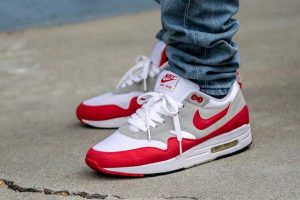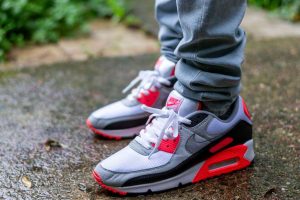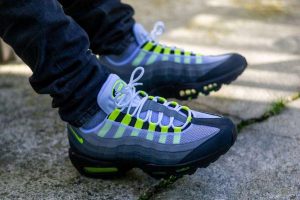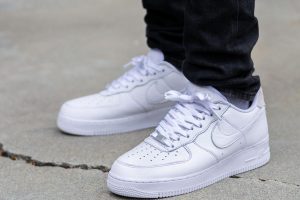My favorite shoe, the Air Max 90, typically costs $130 for the lowest tier pairs. Premium pairs retail for $140-150 or more! Here, we look at why Air Max sneakers are so expensive!
Why Air Max Are So Expensive
Manufacturing costs, overhead, retail markup and profit all play a role in the final price we pay for Nikes. The retail markup is determined by demand, so Air Max are expensive because people want them!

We often hear how Nikes only cost a few dollars to make. For each shoe however, Nike only makes a slight profit as a manufacturer and distributor. A bulk of the retail price of a pair of Air Max is due to retail markup.
Shoes such as the Air Max 1 might cost $30-40 to manufacture, and another $30-40 in shipping and administrative overhead. Nike might pull $20 profit as the brand, and the other $50-70 is the retail markup. I’m making up the numbers here to illustrate the point, which is that the final markup on a shoe is what makes Air Max that much more expensive vs what they cost to produce.
Of course, when Nike sells an Air Max directly on its site or in one of its stores, they get the profit and the markup. So the real question is “What determines the retail markup on a pair of Air Max?”, and the answer is demand. Nike charges an MSRP based on what they think people are willing to pay for the sneaker.
What Is So Special About Nike Air Max
While the Air Max concept was created with the best technology available at the time of its inception, the sneaker has grown to become an iconic fashion staple. The popularity of Air Max sneakers has lead to them becoming more expensive.

Air Max have grown from a performance sneaker into more of a style statement. In fact, Nike has released way better running sneakers while developing different technologies through the years. Most of their newer technical running shoes do not even incorporate an Air unit!
Still, as a casual sneaker, Air Max have only gotten more expensive. This is thanks to demand, as mentioned earlier. People not only rock Air Max kicks for style and fashion, but the sneaker has proven to be collectible as well.
Limited availability and high profile collaborations are a magic formula that sneaker companies apply to certain releases to help bolster a model or category of models. For example, collabs with Patta, Concepts and Atmos, among others, keep attention focused on Air Max models. The increased desirability bleeds onto non-collab colorways. The overall increased demand allows Nike to charge a higher retail price.
The Point Of Nike Air Max
The Air Max line, started by Tinker Hatfield, was initially created to show off Nike’s Air technology by revealing it in a visible Air unit. The idea is to provide better cushioning while reducing weight.

While many sneakers in Nike’s lineup contain an Air unit, and had since the Air Tailwind in the 1970s, none had actually shown the airbag from the outside. This makes a big difference for a running shoe because the Air unit can actually be somewhat functional.
Simply put, the plastics and gasses that comprise an Air unit in a pair of Air Max weigh less than the surrounding midsole material. While Nike currently has other technology that’s even lighter, at the time the Air Max line was revealed to the world, this was considered an ingenious innovation for running.
Air Force 1s Have A Hidden Air Max Bubble
Sneakers like Air Jordan 1s and Air Force 1s do contain Air units encapsulated within their midsoles. However, the encapsulated structure gives little room for an Air unit to flex and removes much of the benefit other than the weight difference.

These have an Air unit,
but not an exposedAir bubble
While Air Maxes and Air Trainers have an Air bubble with visible Air, other Nike sneakers hide the Air technology within the midsole. This is what makes the Air Max special vs other sneakers with Air units.
The exposed Air bubble does not only add to the aesthetic of some Air Maxes. Having it revealed also gives it some space to expand and contract. This actually allows the Air unit to do its job to a higher degree than the encapsulated versions found in other sneakers.
Replacing a chunk of midsole with Air and plastic does help with the weight of a pair of sneakers. This is more pronounced in the Air Max line as the clear bubble goes all the way through the midsole. So while a pair of AF1 might benefit slightly from the reduced weight, a sneaker with a larger Air unit like an Air Max 1 or 90 will benefit even more.
I’m not going to lie, when I wear a pair of Air Max, I don’t always feel the difference outright. It’s not a “squishy” technology like Boost or React. However, if I switch to another pair of kicks such as some Jordan 1s or Air Force 1s, both of which contain an encapsulated Air unit, I definitely notice additional weight and slightly less flexibility in the midsole.
How Long Nike Air Bubbles Last
Assuming the Air unit isn’t popped by something sharp, it can last for more than 5 years. Wearing the sneakers occasionally helps keep the midsole flexible and can increase the lifespan of the Air bubble.
The first instinct collectors have is to keep their limited Air Max in the box. I can’t count how many times I’ve seen sneakerheads “waiting for the right moment to wear these” around on the internet. While this type of activity can help keep the sneakers clean, it is overall bad for the longevity of the sneaker.
Sneaker midsoles are made from different materials, and older Air Max and Jordan midsoles can crumble after they’ve aged a few years. The Air units contain pressurized nitrogen gas, and the surrounding TPU (plastic) can form cracks or leaks over time. Additionally, the glues that hold everything together can dry out.
Newer midsole materials can sometimes offset this a bit, but the issue will still happen eventually. While keeping things pristine is understandable, shoes were meant to be worn! Wearing the sneakers keeps the midsole flexible and helps prevent things from drying out. An Air Max may be destined to collapse and crumble, but its lifespan can be prolonged with occasional wear and good upkeep.
I’ve had pairs last me longer than 10 years by busting them out every few weeks and getting a wear in. Considering how expensive and sought after the Air Max line is, I definitely want to keep each pair I own wearable and in good shape for as long as possible!
